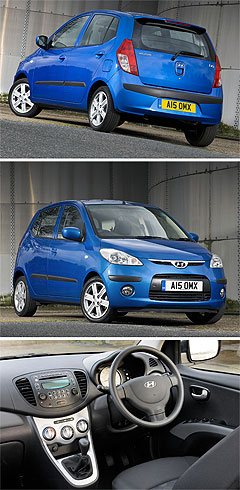Future models - Hyundai - i10Hyundai considers i10 for OzCity-car: Hyundai's i10 is one of many micro-cars on the table for Australia. Hyundai’s i20 will slot above the Getz, but is there room for the smaller i10 below?31 Oct 2008 HYUNDAI Motor Company Australia is considering importing the i10 sub-B segment hatchback to slot in underneath the i20 hatch, which itself is due to join its existing Getz light-car stablemate on sale here in the middle of next year. However, while the i20 will eventually act as a replacement for the ageing TB Getz, which continues on at least until the end of 2009 as HMCA’s entry-level vehicle, if the i10 receives the green light it will not be available for sale in Australia before the end of next year at the very earliest. In the meantime, the i20 will be Hyundai’s first premium light car, and is expected to take the place of the slow-selling MC Accent range when it arrives late in the second quarter of 2009. Expect pricing to kick off from about $15,000 for the well-equipped base model i20, which we believe will also include stability control as standard. With the future of the Getz under a cloud, this would leave a gaping hole in HMCA’s line-up, opening the doors for the i10’s Australian debut.  “We are looking at the i10 for Australia,” confirmed HMCA product manager Manuel Tyras. “But no decision has been made as yet,” he added. The i10 is a five-door hatchback weighing in between 880kg and 1014kg, and is powered by a choice of two four-cylinder petrol engines. A 1.1-litre single-cam 12-valve unit produces 49kW of power at 5500rpm and 99Nm of torque at 2800rpm, while a 1.2-litre twin-cam 16-valve engine delivers around 55kW at 5200rpm and 116Nm at 4000rpm. Drive is directed to the front wheels via a five-speed manual or – more importantly for Australia – a four-speed automatic gearbox, while suspension is via MacPherson struts at the front and a torsion beam rear axle. According to HMCA communications manager Ben Hershman, Hyundai is keen to gauge public reaction to the i10 before it commits to selling the car in Australia. “We are right at the beginning of the i10 program,” he revealed. “Honestly, we don’t know yet what we are going to do.” Working in the i10’s favour is the fact that it is built at the same production site as the i20 in Chennai, India, even though the two vehicles are built in different platforms. One company insider said that, pending homologation issues, it would not be logistically too difficult to also import the i10 if the i20 is already brought into Australia. However, strong overseas demand for the i10 may also affect its availability. It has already received strong critical reviews in Europe, particularly as Hyundai has priced the vehicle considerably below most rivals. HMCA will watch the sales performance of the new Suzuki Alto very closely when it is launched in Australia in the second quarter of next year. Like the i10, the Alto is also built in India and, as is designed to slot underneath the larger ‘light car’ category known internationally as the B-segment. In the Suzuki’s case, this means the Alto will undercut the $15,990-plus Swift by a significant margin, although the Japanese company has yet to reveal what the Alto’s price will be. Only the Proton Savvy and Smart ForTwo fit the sub-B sizing requirements, if not pricing, as the latter is actually more expensive than some C-segment small-car contenders. Other manufacturers thought to be considering the introduction of sub-light-sized vehicles into Australia include Ford (Ka II), Holden (2010 Daewoo Matiz replacement, thought to be called the Beat), Toyota (iQ), and Mitsubishi (i-car). Read more:Hyundai shines its i20 light at ParisAll future models Alfa Romeo Alfa Romeo Abarth Abarth Audi Audi Aston Martin Aston Martin BMW BMW Bentley Bentley Chrysler Chrysler Chevrolet Chevrolet Dodge Dodge Citroen Citroen Ferrari Ferrari DS DS Ford Ford Fiat Fiat FPV FPV Foton Foton Haval Haval Great Wall Great Wall Honda Honda Holden Holden Hyundai Hyundai HSV HSV Isuzu Isuzu Infiniti Infiniti Jeep Jeep Jaguar Jaguar Lamborghini Lamborghini Kia Kia Lexus Lexus Land Rover Land Rover Mazda Mazda Maserati Maserati Mercedes-Benz Mercedes-Benz McLaren McLaren Mini Mini Nissan Nissan Mitsubishi Mitsubishi Peugeot Peugeot Opel Opel Proton Proton Porsche Porsche Renault Renault Ram Ram Saab Saab Rolls-Royce Rolls-Royce Smart Smart Skoda Skoda Subaru Subaru SsangYong SsangYong Tesla Tesla Suzuki Suzuki Toyota Toyota Volvo VolvoMotor industry news |
Click to shareHyundai modelsResearch Hyundai All future models Alfa Romeo Alfa Romeo Abarth Abarth Audi Audi Aston Martin Aston Martin BMW BMW Bentley Bentley Chrysler Chrysler Chevrolet Chevrolet Dodge Dodge Citroen Citroen Ferrari Ferrari DS DS Ford Ford Fiat Fiat FPV FPV Foton Foton Haval Haval Great Wall Great Wall Honda Honda Holden Holden Hyundai Hyundai HSV HSV Isuzu Isuzu Infiniti Infiniti Jeep Jeep Jaguar Jaguar Lamborghini Lamborghini Kia Kia Lexus Lexus Land Rover Land Rover Mazda Mazda Maserati Maserati Mercedes-Benz Mercedes-Benz McLaren McLaren Mini Mini Nissan Nissan Mitsubishi Mitsubishi Peugeot Peugeot Opel Opel Proton Proton Porsche Porsche Renault Renault Ram Ram Saab Saab Rolls-Royce Rolls-Royce Smart Smart Skoda Skoda Subaru Subaru SsangYong SsangYong Tesla Tesla Suzuki Suzuki Toyota Toyota Volvo VolvoMotor industry news |














Facebook Twitter Instagram